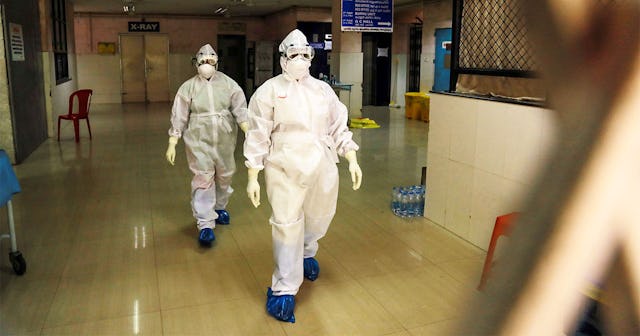Experts Say Nipah Virus Has Potential To Be Another Pandemic — With A Higher Death Toll

Earlier this month, a twelve-year-old boy in Kerala’s Kozhikode district in India died from the Nipah virus, a virus that most people probably never heard of. A virus that, according to experts, has the potential to become another global pandemic with a significantly higher death toll.
Approximately 70 percent of people who are infected with the Nipah virus die, says Dr. Stephen Luby, a professor of infectious disease at Stanford University. When the virus first appeared in Malaysia in 1999, it killed more than 100 of the approximately 300 people that had been infected. When it emerged in Kerala in 2018, only two of the nineteen people who’d contracted Nipah survived.
Often even survivors are left to suffer. Many are left with long-term consequences, including “persistent convulsions and personality changes,” according to the CDC.
For those reasons and others, the World Health Organization declared Nipah a “virus of concern” and experts are urging more research and attention.
Nipah Virus Is A Zoonotic Virus
Similar to coronavirus, Nipah is a zoonotic virus, which means it can spread between animals and people. Generally, transmission happens when a person consumes contaminated food or comes into direct contact with an infected animal. Fruit bats “are the natural carriers of Nipah.” Once Nipah spreads from an animal to a person, that person can go on to infect other humans.
Though it’s still uncertain, experts believe contaminated food caused this current outbreak.
“One plausible theory is that those who’ve been infected [in Kerala] ate food or fruit contaminated with bat saliva or excreta,” Dr. Thekkumkara Surendran Anish, associate professor of community medicine at the Government Medical College in Thiruvananthapuram told NPR.
Nipah Is Not Easily Transmissible…Yet
BSIP/UIG/Getty
The good news—if there can ever be good news when discussing a deadly virus—is that Nipah virus is not very transmissible.
“There are occasional Nipah superspreaders who infect a lot of people,” says Luby. “But the average transmission rate is less than one person per infection.”
Considering we’re currently fighting a highly contagious respiratory virus with a highly infection variant, that’s news we want.
However, that good news might (only might) be temporary. Luby notes that, “[E]ach time a person is infected, the virus is in an environment that selects for human adaptation and transmissibility. The risk is that a new strain that is more efficiently transmitted person to person could generate a devastating outbreak.”
As we’ve learned too well—viruses mutate. And when they mutate, they could spell even more trouble.
Availability Of Vaccines Or Treatments
Unfortunately, we don’t yet have a cure or vaccine for Nipah virus, though there is hope on the horizon. (Once again, let’s take a moment to thanks scientists and doctors who work tirelessly to protect us from current and potential pandemics!)
Alongside a potential vaccine candidate, researchers are looking to a drug called M 102.4. One study found that in Phase I clinical trials, the drug was able to neutralize Nipah.
Neutralizing the virus before it can cause damage is important, considering how troubling Nipah virus symptoms can become. Initial symptoms include fever and headache, which can last for three days or up to two weeks. After that, an infected person can expect sore throat, cough, and respiratory issues. Soon thereafter (too soon), the symptoms turn severe. Nipah can cause swelling in the brain cells, which leads to drowsiness, confusion, and potentially coma and death.
The CDC notes that remdesivir (also used against COVID-19) has shown some effectiveness in nonhuman primates when given prophylactically after exposure.
If Nipah Goes Global…
C. K Thanseer/DeFodi images/Getty
The Nipah virus is seemingly currently under control in Kerala, but experts warn we can’t let down our guard. “[A]s long as there’s a lot we don’t know, the possibility of an epidemic can’t be ruled out,” Anish says.
Prevention is key. Along with “standard infection control measures,” the CDC encourages anyone who lives in an area where Nipah outbreaks have occurred to practice good hand hygiene, avoid sick bats and avoid anywhere where bats roost, avoid consuming raw date palm syrup, avoid consuming fruits potentially contaminated by bats, and avoid contact with blood or fluids of any person infected with Nipah.
Likewise, the WHO urges anyone consuming fruit or fruit products (like raw date palm juice) to wash thoroughly and peel the fruit before consuming it in order to decrease the risk of international transmission. Also, discard any fruit with signs of bat bites.
Right now, Nipah has been identified in Malaysia (during the 1999 outbreak) and Bangladesh and India. As our world shrinks due to international travel and trade, and as climate change forces bats into new habitats, that could change.
“We observe [fruit bats] here [in Cambodia] and in Thailand, in markets, worship areas, schools and tourist locations like Angkor Wat – there’s a big roost of bats there,” Veasna Duong, head of virology at the Institut Pasteur research lab in Phnom Penh, Cambodia told the BBC’s Future program. “In a normal year, Angkor Wat hosts 2.6 million visitors. That’s 2.6 million opportunities for Nipah virus to jump from bats to humans annually in just one location.”
From there, it’s not hard to imagine one of those 2.6 million opportunities hopping on an international flight and leading to another global pandemic. One that’s a lot deadlier and a lot harder to treat.
This article was originally published on